
views
Designing Your Kitchen

Hire a contractor if you need to install utility lines. You can construct basic bases and cabinetry for an outdoor kitchen on your own. However, if you want to include a sink, refrigerator, and other extra features, you'll need a professional to install plumbing and electrical outlets. If you don't want to lug around propane tanks, you'll also need a professional to run an underground gas line. Have a professional install any needed utility lines before you install your base cabinets. Try to come up with a design for the layout, then have them install connections to fit your configuration.
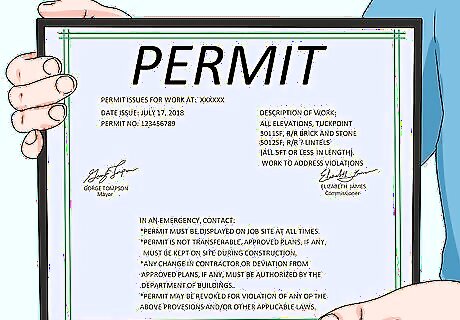
Figure out if you'll need permits. Some areas require building permits for plumbing and gas line installations and for work exceeding a set amount of money. If you hire a licensed contractor or electrician, they will be knowledgeable about your jurisdiction's building codes. If you're just working on your own, contact your local building or code enforcement department.
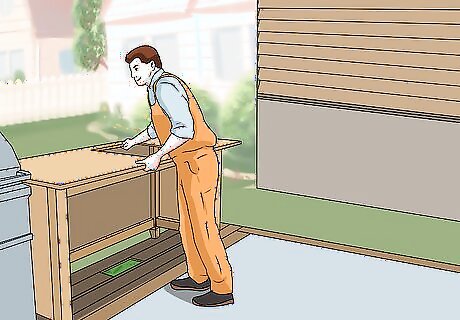
Keep the kitchen near your home. Set up the kitchen near your home instead of in the middle of your yard. An exterior wall will lend protection from the elements. Utilities are also cheaper to install if the space is next to the house.
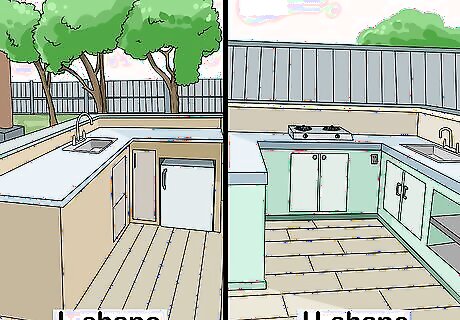
Choose a configuration that fits your space and budget. Depending on your budget and available space, choose a line, L-shape, or U-shaped configuration. The most affordable configuration is a simple line setup, which would sit against your home or extend out as a peninsula. It would consist of a grill flanked by bases with cabinetry and countertops. You could also designate spots for a sink and mini-refrigerator, but space might get tight. L-shaped configurations are more elaborate and more expensive. The grill, flanked by cabinet bases, could sit against your home. More bases with cutouts for a mini-fridge, sink, and storage could extend out as a peninsula to form an L-shape. If you have more space available, you could extend another peninsula on the other side to form a U-shape. Keep in mind a more elaborate setup will require more building materials and, if you're hiring someone, higher labor costs.
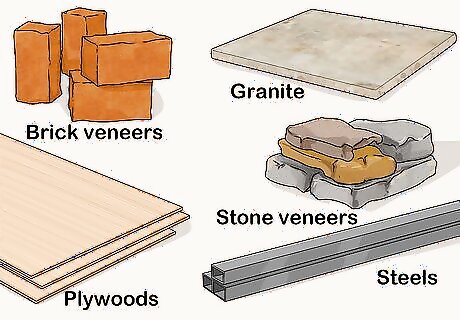
Choose your materials. Use weather-resistant materials for your cabinetry and countertops, like brick veneer and granite. In addition, take your home's materials into account when you choose what to use for your outdoor kitchen. For example, if your home has a stone or brick facade, you could cover your cabinet bases with a durable brick or stone veneer. If you're building your own bases, the easiest DIY method is to use treated plywood to construct a frame, then cover it with a brick or stone veneer. Since wood is combustible, you'll need to install an insulated grill tray (if your grill will be built-in) and cover the frame with wire lathe before adding mortar and the veneer. If you're having a contractor build your bases, they'll use a steel or concrete frame to support the veneer.
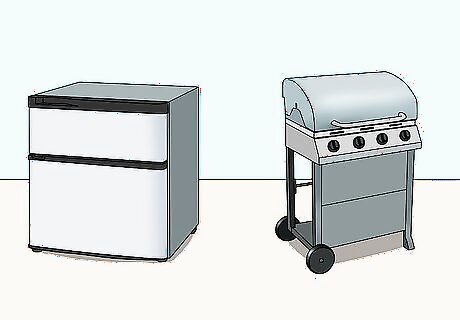
Choose your appliances before building cabinetry. It's wise to purchase your appliances before construction, especially if you're building your own cabinet bases. If you already have your grill, mini-fridge, and other features, you'll be able to construct cabinetry with cutouts and overall dimensions that match your appliances. In addition, your layout will depend on which appliances you need. For instance, work a gap between 2 cabinet bases into your design to match the size of a mini-fridge. If you know your fridge's dimensions from the start, you can make your cabinets the same height so the countertop will fit seamlessly over the cabinets and fridge. Make sure your appliances are rated for exterior use.
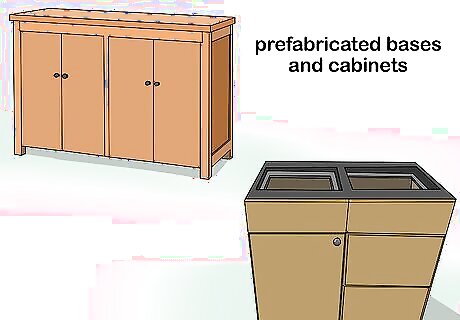
Look into getting prefabricated bases and cabinets. Buying prefabricated bases is more affordable than having custom cabinets built. Installing ready-made bases is also easier than having cabinets made or building them yourself. You can find prefabricated cabinetry manufacturers online. Most manufacturers' websites include design tools that allow you to match the base modules to your space's footprint. Once they're delivered, you can arrange and connect the bases using metal fasteners and construction adhesive. You can purchase bases with openings for gas, water, and electrical lines, then have a professional plumb or wire them.
Building Your Own Bases and Cabinetry
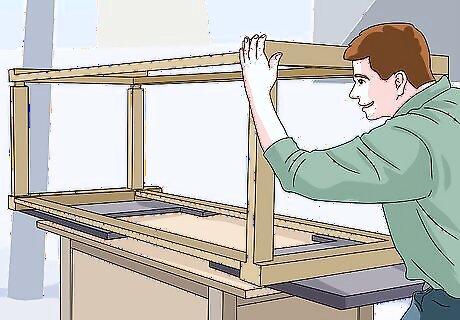
Construct base frames out of plywood boards. Attach 2 boards to each other with 2.25 inches (5.7 cm) screws to create a corner post, then repeat the process to make 4 corner posts per base module. Screw boards horizontally into the tops and bottoms of the corner posts to create a box frame. Finish by screwing boards across the bottom of the box where you want to include cabinets. Use a circular saw to cut your plywood boards to the right sizes. You'll want your bases' total height to be about 38 inches (97 cm), but you'll need to factor in your the height of your countertop when you cut your plywood posts. Subtract your countertop height from 38 inches (97 cm) to find the right height for your corner posts. To create cube-shaped modules, make your horizontal boards the same size as your corner posts. You could make multiple modules, place on on each side of your standing grill, and add others to create a peninsula.
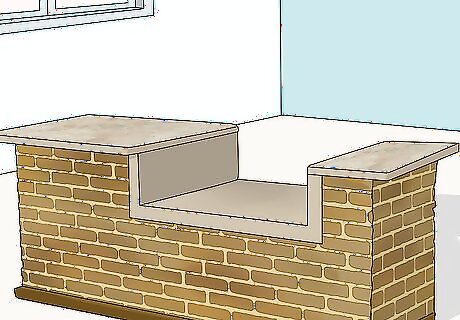
Leave room for an insulated jacket for a built-in grill. If you have a built-in or drop-in grill, purchase an insulated jacket that fits the grill. Build a smaller plywood box frame to fit the grill jacket's dimensions, so the jacket will sit at the top of the box. The grill will fit into the jacket on this module, then you'll place your full-height modules on either side. An insulated jacket is needed to contain the heat produced by the grill. If you already have a standing grill, you can just build your cabinet modules and place them around your grill.
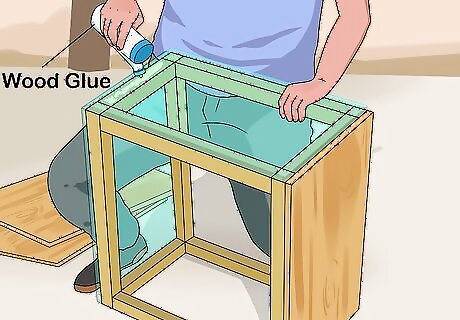
Cover the box frame with plywood panels. After building your box frame, cut plywood panels to match the box's dimensions. Use a jigsaw to cut out spaces in the panels for cabinets. Apply a bead of woodworking glue across the plywood posts on one face of the box, press a plywood panel onto the face, then secure it with screws. Glue and screw on the plywood panels onto the other 3 faces of the box, leaving the top and bottom open.
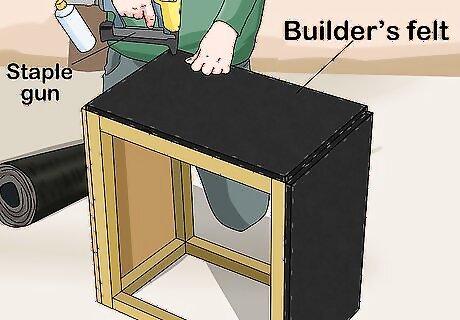
Use a staple gun to cover the plywood panels with builder's felt. After sheathing your frame with plywood panels, cover each side with builder's felt. Secure to the plywood with staples every 6 inches (15 cm). Remember to include cutouts for cabinets in the felt to match those cut into the plywood panels.
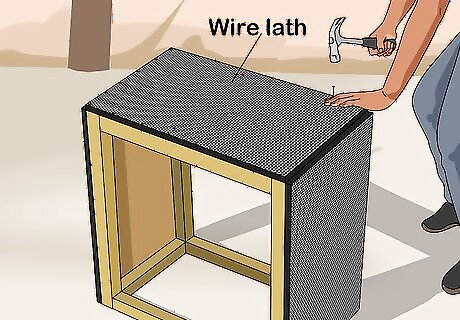
Nail sheets of wire lath over the felt. Feel for the side of the lath with a textured honeycomb pattern. This side should face out. Lay sheets of lath over the felt on all sides, and hammer nails every 6 inches (15 cm) to secure the lath. Trim the top of the lath so it's flush with the top of the frame. Wear gloves when working with wire lath. Remember to include cutouts for the cabinets in the lath.
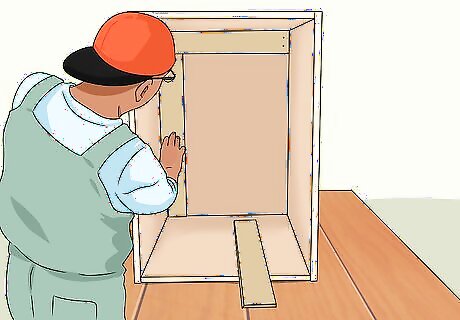
Build cabinet boxes. Cut plywood panels to create boxes that fit into the cutouts made in the base. Cut a bottom and 3 sides, then apply woodworking glue and screw them together to create a 3 sided, topless box. Create a flange, or projection for the door, by cutting strips of plywood 1 inch (2.5 cm) wide and 1.25 inches (3.2 cm) deep. Glue the strips to the front of the cabinet box to form a continuous lip around the front face. Create a cabinet box for each cutout you've made in your modules. Set the boxes aside until you've laid a scratch coat of mortar. You can't just repurpose old interior cabinets without building a veneered base around them. They won't hold up to the elements.
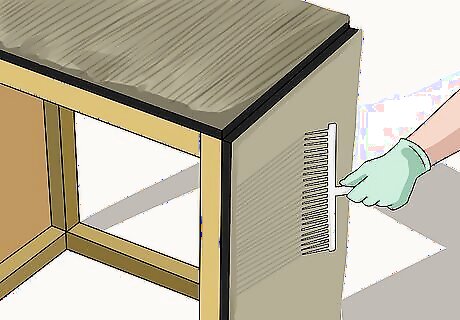
Apply a scratch coat of mortar. Once you've made enough modules to fit your design, place them where you want your outdoor kitchen and arrange them so they're in their approximate final positions. Mix mortar to create a peanut butter-like consistency, then cover the lath with a 1 inch (2.5 cm) coat. Allow the coat to cure for an hour. Before you start working, lay a border of scrap boards around the base to catch excess mortar.
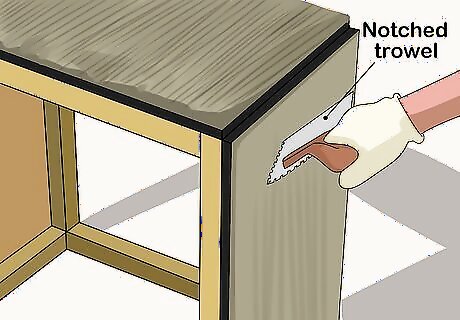
Score the mortar after an hour. After an hour, score the surface of each mortared face with a notched trowel. Run the trowel across the surface horizontally to create lines over each side. These scores will help hold the veneer to the surface.
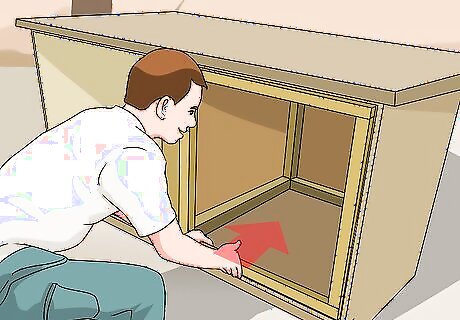
Install the cabinet boxes. After you've scored the scratch coat, slide your cabinet boxes into the cutouts. Drive screws to secure them to the base, and make sure the flange, or lip, on the front face projects 1.25 inches (3.2 cm) so it can accommodate doors later.
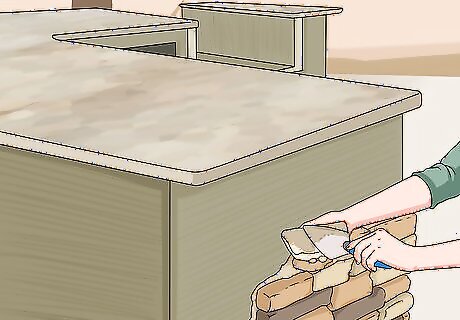
Lay your brick or stone veneer. Butter the back of an L-shaped corner piece with mortar, then set it into a bottom corner of your base so it rests above the scrap boards. Continue buttering and laying bricks or stones in either direction until you've finished the first row, then proceed laying the veneer until you've covered the entire base. Dry mount your veneer pieces before mortaring them to double check their fit. Don't cover the flanges, or lips, of the cabinet boxes with veneer. Leave the flanges exposed so you can screw your door hinges onto them. Allow the veneer to set for 24 hours.
Adding Final Touches
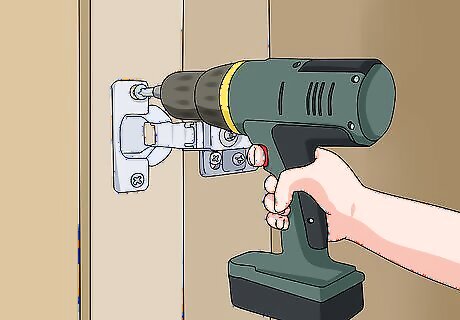
Hang cabinet doors. If you can find steel doors that fit your design, they're the most durable option. If you can't track any down, you can trim old wooden cabinet doors or cut wood panels to fit your project. Screw the hinges onto the flange, then screw the hinges onto the door. If you have to go with wooden doors, seal them with a wood varnish labeled for exterior wooden furniture. After 2 or 3 years, you'll probably have to sand the doors and freshen the varnish.
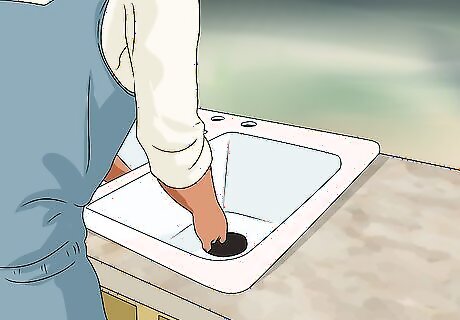
Install the sink if you've included one in your design. Position the sink basin on a base module. Make sure you have a professional plumb the site in advance, and connect the water supply line and drain.
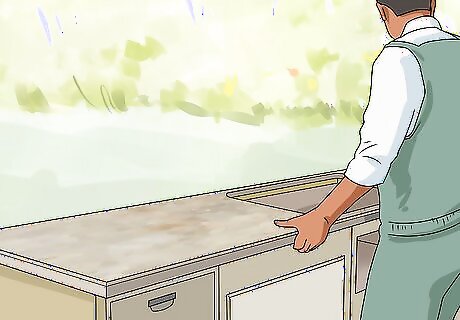
Install the countertop. Order natural stone and have the manufacturer cut it to fit your project. Make sure to specify a sink hole if your design includes a sink. Cut plywood panels to precisely fit the tops of your base cabinets, and secure the panels to the modules with screws. Fit the stone sections over your modules to test their fit, then glue them down with a silicone adhesive. If there's a problem with the fit, have the stone delivery person or manufacturer make adjustments with a diamond-tipped saw.
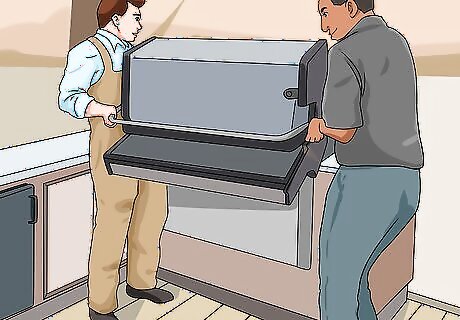
Position your grill and other appliances. With your cabinetry and countertops in place, you can insert your drop-in grill into the insulated jacket. If you had a gas line installed, connect the grill to the line. If you have a standing grill, slide it into place between your base modules. If you've included a mini-fridge in your design, plug it in and slide it into its designated space.




















Comments
0 comment